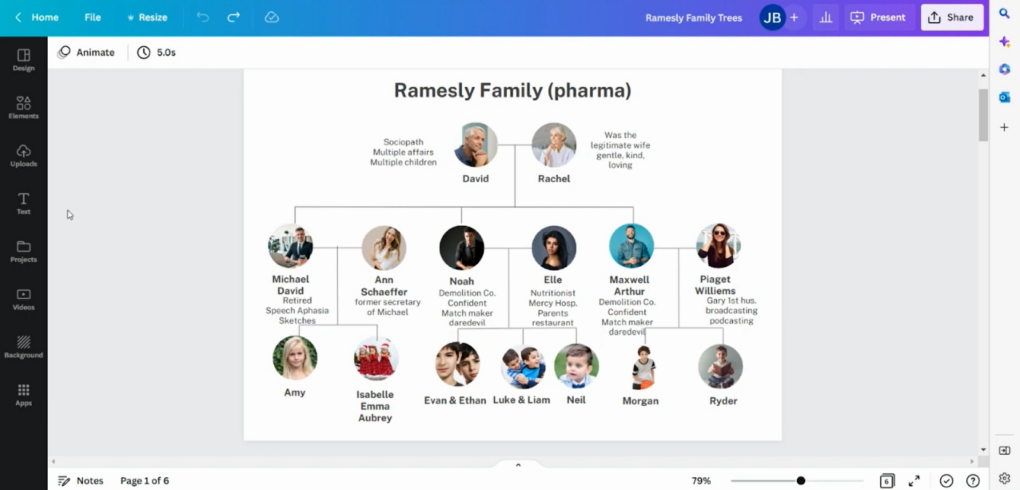What if your family tree were a work of fiction? Today, I’ll introduce platforms for crafting fantastical family trees.
Long-time enthusiasts might chuckle, asking, “Aren’t we to create accurate family trees?” Absolutely, but occasionally, people desire fictional family trees. Authors might weave fictional elements into real-life personas. However, today we’ll explore tools for intentionally crafting fictional lineages.
| Website | Main Features |
|---|---|
| Canva | User-friendly interface, diverse templates |
| FamilyEcho | Easy information input, intuitive tree building |
| Creately | Suitable for complex trees, customizable |
| Famberry | Dual functionality for genealogy or fictional trees |
| Genealogy Software | Robust tools for in-depth tree creation |
| MyHeritage | Private tree option, suitable for fictional trees |
| FindMyPast | Private tree setting, versatile for imagined ancestry |
| Ancestry | Private tree feature, adaptable for fictional trees |
| Lucidchart | Versatile for both genealogy and imaginative trees |
| RootsMagic Essentials | Basic software for straightforward family trees |
| Legacy Family Tree | Comprehensive features for intricate lineages |
| Family Tree Maker | Robust software with diverse charting options |
Canva

Canva offers a user-friendly platform with both free and premium options. For a straightforward family tree layout, Canva fits the bill!
It boasts vibrant, inspiring family tree templates. Upon selecting a template, I tailored the tree to my preferences. Adding shapes and lines was a breeze with Canva’s intuitive tools. Once done, you can print your tree for wall display.
FamilyEcho
I came across a website called FamilyEcho, which I find especially impressive for creating fictional family trees. Through the sidebar, you input information about relatives, partners, and biographical details. FamilyEcho then constructs the tree accordingly.
You have the flexibility to add partners, siblings, children, and even secondary sets of parents. As you expand, nodes help navigate between a couple’s ancestors. For instance, in the given view, Ross Poldark’s lineage is visible. Clicking the node above Demelza reveals her parents. For more intricate family trees beyond Canva’s capabilities, this free and user-friendly website is an excellent choice.
Creately
For crafting intricate fictional family trees, another option is Creately. An alternative called Lucidcharts exists as well. I’ve received recommendations for Lucidchart over the years. Regrettably, my experiences with it have been quite glitchy.
Yet, I’ve discovered that Creately serves as an excellent substitute for Lucidcharts. It features user-friendly family tree templates, although the lines may appear slightly irregular due to their flow-chart nature rather than a family tree format.
Famberry
I strongly endorse the aforementioned choices for crafting fictional family trees. However, I wouldn’t suggest them to genetic genealogists or researchers due to their restricted capabilities. Famberry sets itself apart. It caters to both genealogy family trees and fictional ones.
Personally, I prefer Famberry for its feature of easily adding pictures to profiles. While other platforms support photo inclusion, it’s not as straightforward. Adding images to Famberry was incredibly convenient, “Super easy. Barely an inconvenience,” as the ScreenRant phrase goes.
When crafting a fictional narrative, managing various events in a character’s life is crucial. As you construct an intricate family tree, the need for a timeline of events arises. Famberry simplifies this aspect seamlessly.
Genealogy Software

You also have the option of utilizing conventional family tree construction tools like genealogy software.
Consider:
- RootsMagic;
- Legacy Family Tree;
- Family Tree Maker.
Genealogy software empowers you to forge an extensive family tree, establish a timeline, generate charts, and perform tasks akin to the previously discussed choices. If you’re tackling numerous novels with diverse characters, this could serve as a viable solution.
However, it’s worth noting that, apart from RootsMagic Essentials, these programs require payment. Thus, the question arises: How much are you willing to invest in crafting your imaginary family tree?
Exploring Online Family Tree Platforms
Lastly, you can turn to online family trees. My recommended choices for crafting a fictional family tree in this context would be MyHeritage, FindMyPast, and Ancestry.
Essential here is marking it as a private tree. Broadcasting fabricated unions like Ross Poldark marrying Demelza Caren in Truro in 1784 isn’t desired. Why share what’s untrue?
Should you venture into constructing a fictional lineage, these platforms offer avenues for crafting free fantasy family trees. It’s important to note, though, that the free versions come with limitations on the number of individuals you can include in your tree.
Conclusion
Which Tools to Choose for Crafting a Fictional Family Tree? I hope you enjoyed this bit of fun! Stay tuned for our upcoming blog posts.
For fellow fictional writers embarking on their genealogy journey, explore our posts on starting your genealogical quest.
